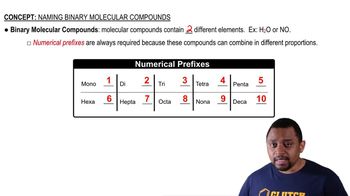Here are the essential concepts you must grasp in order to answer the question correctly.
Ionic Compounds
Ionic compounds are formed when atoms transfer electrons, resulting in the formation of charged ions. These compounds typically consist of a metal and a non-metal, where the metal donates electrons and the non-metal accepts them. The electrostatic attraction between the oppositely charged ions holds the compound together. An example is lithium phosphate (Li₂HPO₄), which contains lithium ions and phosphate ions.
Recommended video:
Molecular Compounds
Molecular compounds are formed when two or more non-metal atoms share electrons through covalent bonds. These compounds usually consist of discrete molecules rather than a lattice structure, and they can exist in various states (solid, liquid, gas) at room temperature. An example is water (H₂O), where hydrogen and oxygen atoms share electrons to form a stable molecule.
Recommended video:
Naming Binary Molecular Compounds Concept 1
Nomenclature of Compounds
Nomenclature refers to the systematic naming of chemical compounds based on their composition and structure. For ionic compounds, the name typically includes the cation (positive ion) followed by the anion (negative ion), while molecular compounds use prefixes to indicate the number of atoms present. Understanding nomenclature is essential for accurately classifying and naming compounds like Li₂HPO₄, which is named lithium hydrogen phosphate.
Recommended video:
 Verified step by step guidance
Verified step by step guidance Verified video answer for a similar problem:
Verified video answer for a similar problem:



 1:10m
1:10m